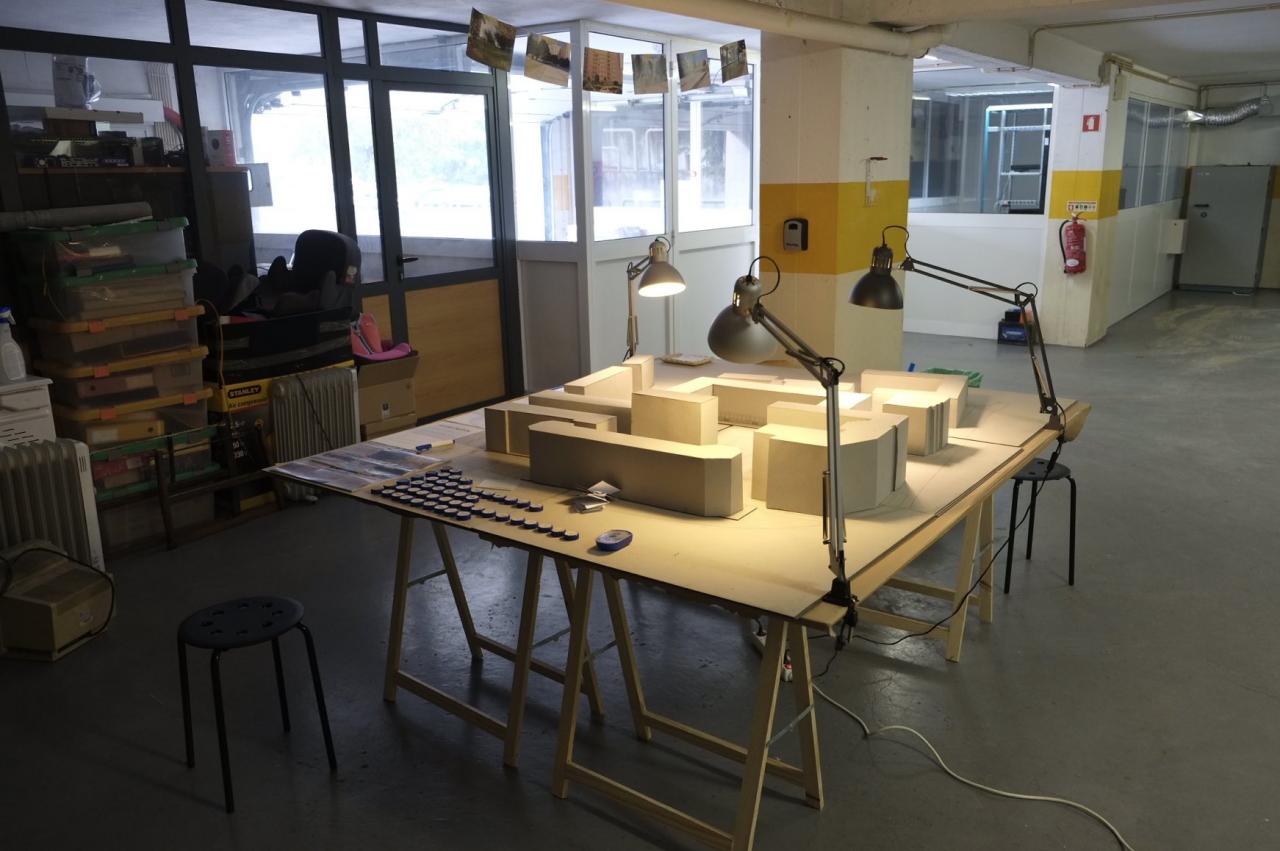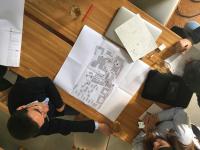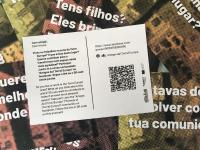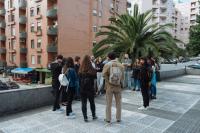
A group of citizens resident in the urbanisation around Praceta João Beltrão, in mid-2020, started a movement to show their discontent with the construction works that the municipality of Braga was carrying out in the public spaces of that area.
Such construction works are part of the project Áreas Mais (Area Plus), a municipal initiative integrated in the city’s sustainability and decarbonization policies, which defines an integral restructuring of the public space, favouring ways of soft mobility, mainly pedestrian ones, rather than the use of the automobile. The project proposes the increase of the pedestrian area, making it safer and more accessible, and the decrease of the automobile space, as a measure of reducing traffic and creating conditions of accessibility for everyone, whether through reducing the number of traffic lanes or reorganising parking spaces. The public discussion of this project took place in 2018, with initiatives in the public space and the involvement of the parish councils, but the construction works for the implementation of this project only started in September 2019, in four areas of the city, as a result of meeting the deadlines imposed by the public procurement and funding application. As so, the response to this process continues, not during public participation, but in the setting up of the worksite. The community is starting to build itself alongside the construction works. The municipality’s expectations are that these four pilot projects serve as a reference to their application in other areas of the city.
The discontentment of this group of citizens was essentially focused on the reduction of the number of parking spaces after the intervention. Despite the substantial number of flats in this area having underground spaces for private parking, many families have more than one car per household, which increases the need for parking spaces at a street level. To make matters worse, there are cases in which the garages were poorly built, making their use impossible for automobile parking, which results in cars being necessarily parked in the area’s public spaces. However, this intervention is part of a set of integrated mobility policies and will be a strong contribution to the general discontentment. Nevertheless, the public transportation efficiency will be able to answer these citizens’ needs, causing a desired change of behaviours. At the same time, it is urgent to find solutions and give answers to the carrying out of accessibility features in these urbanisations, in which the right to the city and the public space was compromised by the design adopted in its construction and by the frequent “savage” occupation of cars that park on pedestrian crossings and footways, making mobility even worse in these locations. Braga, in the 1990s, was built over time according to the land registry and isolated land parcelling operations that were consecutively licensed, in a perspective of opening the city to the use of the automobile. And it is, then, in the surroundings of the historical centre, in the consolidated city, that we find the lowest quality urbanisations, a consequence of a quick growth and weak planning, where we perceive an urban environment in need of revitalization, and where there is a demand for an integrated approach at the level of urban rehabilitation, mobility and urbanisation.
The conflict grew and became a matter of news in the local media and the subject of debate and internal and external contestation to the municipality, during the execution of the construction works. Then, if the Áreas Mais project has such pertinent and urgent goals for contemporary cities, aiming at a more democratic and accessible city and promoting more sustainable mobility systems, what has failed and led to the discontentment of some citizens? How can the municipality design a city that, on the one hand, meets the needs of great mobility and sustainability challenges placed on contemporary cities, and on the other hand, makes its citizens feel represented and included in these processes? How is it possible to give answer to a right enshrined by law – accessibility for everyone – promoting inclusion and the right to public space, the right to the city, the adoption of measures for reducing traffic and promoting road safety, in a city where the number of people hit by vehicles is concerning? How is it possible to meet decarbonization goals and adopt more sustainable ways of mobility, and at the same time retain the “savage” parking in all the area? How can the use of the automobile and the option of having more than one car by household compromise these plans? If there is such a large automobile dependence, how can the municipality promote transition initiatives in a way of inciting new mobility habits?

Urbact Network
Despite the projects already being established and the applications and construction procurement being underway, when Braga joined the URBACT: Urban Regeneration Mix network, in January 2019, works on the project Áreas Mais had not yet begun. This network, which Braga shares with the cities of Lódz, Toulouse, Baena, Birmingham, Bologna and Zagreb, deals with matters of public involvement and participation, in processes of urban regeneration. One of the central methodologies at URBACT is the creation of a URBACT Local Group – ULG, which should be composed by several stakeholders of the city, which will, over the period of two years, work on the subject matter in question and cooperate, through the exchange of ideas and experiences, with the ULGs from other cities of the network.
In the first meetings that the URBACT Local Group held, it became clear that the Áreas Mais initiative would be the ideal case study to promote the public debate and challenge the municipality to deepen and outline a strategy of public participation policies.
The lack of community
The project Áreas Mais had already been imagined since 2016 and since then the municipality had been meeting with several persons, associated to each one of these areas, such as parish councils and local associations, in the sense of getting feedback and comments on the projects. However, it is important to highlight that these areas have a strong tenancy nature, which makes any attempt of consolidating the community more dynamic. The Área Mais project defined for the Praça do Bocage is the stage of occupation of several communities from various countries and that have found in it a place to live and work. As such, regarding a more direct contact with the resident population, the work was more challenging. Intervention areas of the project Áreas Mais correspond to recent areas of the city, built in the last 40 years, consisting of a population that has established itself there in a tenancy logic and though estate agency promotion. This spontaneous population hasn’t had the basis, nor the necessary time to establish itself in a common identity basis and form itself as a community. This lack of sense of community or established group – such as residents’ association – poses, from the very beginning, a great challenge regarding participation matters. Only one of the four Áreas Mais areas had one residents’ association established and it was, of all of them, the least contested intervention by public opinion, despite its model and principles being the same. In this sense, to whom must the municipality resort to, or approach, in order to start a dialogue or an interaction in the sense of designing a participated project? How to find a group of citizens that represents the local community? How can we call into question rights enshrined by law – accessibility, safety, public health – rather than an individual option of using the automobile? How to safeguard the common interest above the individual interest of each one?
Meetings in the public space
In September 2018, a year before the construction works began, the municipality, along with the technical team, held meetings directly in the public space of these urbanisations, in an attempt to take the discussion to the community, reaching the residents and allowing changes, still possible in the projects, without ever calling into question its guidelines – the right to public access to all citizens. The meetings were made public through local media and were attended by around three dozen people and the parish councils in each initiative. Then, the most aware and informed residents joined the meetings. However, the number of reactions to these meetings were small and the project advanced without much contribution from the community.
The case of the urbanisation of Montélios
One of the exception cases of this relationship with the community was the case of the project Áreas Mais for the urbanisation of Montélios. This was the only urbanisation of the project in which existed an already established residents’ association. A notebook with major concerns to be addressed in the area was prepared by the Residents’ Association, signed and approved by the Parish Council’s bodies. The entire project design was based on it. However, the principles of the intervention and the adopted model for the planning of the public space followed the same principles of the remaining areas. Throughout the process of planning project Áreas Mais for this area, the exchanges with this association, and by consequence with the residents of the urbanisation, has made the process more fluid and closer to those expectations of all parties involved. It ensured, above all, throughout the whole process, a fundamental mediation with the residents in the face of the options that were chosen from the urban design point of view. This intervention is in fact a case of success in the collaboration between municipality and the community.

How to create a sense of community?
In any case, the most recurrent scenario is the non-existence of agents that embody the sense of community. In the face of this context, we ask ourselves, in the workgroup, within the scope of the Urbact (ULG) project: “How can the municipality formalize a participative project, while meeting tight deadlines imposed by the procedures of public contracting and community funding, when, in the intervention site, there’s not an established and represented community?”. On the one hand, the municipality has a great desire to achieve and involve residents in the processes, but the moments of involvement of the community did not meet the expected success, with the exception of Montélios. And, on the other hand, it recognises human inertia (caused by the lack of technicians available and qualified to voice the participation) and temporal and financial inertia that these processes require. These two conditions result in a deficit of resources to carry out the participation. Answering the question, in May 2019, the ULG decided to select one of the urbanisations of the project Áreas Mais – Praça do Bocage – maybe the one that presented itself as the most critical one of the four ongoing pilot projects. The group decided to formalize two initiatives in this area as a way of testing solutions for reaching the community and promoting participation. The first initiative was the creation of a communication channel with the population through a Facebook group. The second initiative was to invite the School of Architecture of the University of Minho to join the ULG and create and experimental project in the area.
Facebook group "Friends of Praça do Bocage”
The communication channel with the community would have to be fast and effective, and a Facebook group would allow for this. First, the ULG created the group and called it "Friends of Praça do Bocage". The second challenge was to understand how we could make a first contact and invite the residents to join the group. The solution found was inspired by the "Guillaumet" project, shared by the partners from Toulouse in this URBACT network. Faced with the difficulty of involving the residents living in Guillaumet (a former military area which would be the target of an urbanisation process) in a participatory project, the city of Toulouse launched an invitation campaign, where it randomly addressed letters to people, on the street or in the supermarket, with generic and common characteristics, such as "a letter to the lady walking the dog" or "a letter to the gentleman in the blue coat". This creative methodology mobilized a group of residents of the area to the meetings of the participation project which, in turn, invited more people. In Braga, we decided to adapt and replicate this activity, designing postcards that were addressed to the residents of Praça do Bocage to invite them to join the Facebook group. On one side of the postcard, we asked a general question about the area of Praça do Bocage, such as "what do you think of the garden in the square?" or "what time of day do you most like to walk around the square?" and, on the other side, a more formal invitation for the person to join the facebook group through a link and a QR Code. These postcards were then distributed to all the mailboxes of the buildings around Bocage Square. In just one week, the group gained more than 70 people out of the thousands estimated to live in this area.

Partnership with the University of Minho
The integration of the University of Minho in the ULG group resulted in a partnership, in the sense of creating an experimental field to test and simulate methodologies of participation in the urbanisation around Praça do Bocage. The partnership was established with the curricular unit "Public Space", from the 5th year Integrated Masters in Architecture, where students were encouraged to critically position themselves before these processes of urban regeneration and challenged to propose models of interaction with their residents.
In addition to winter semester work that the students had to carry out, in order to be evaluated for the curricular unit, an intensive workshop was held during one week of November 2019, in loco, at Praça do Bocage. During this period, the works for the implementation of the project Áreas Mais had already begun and, as such, some members of the community were already showing the first signs of discontent. During this week, the students had the opportunity to test some models of interaction with the community, which they were already discussing in class. From the conclusions reached by the students, and from parallel initiatives in progress, some topics emerged, such as the need, in future projects, for the municipality to invest in a neutral mediator, who would accompany these processes from conception to implementation, and in the creation of campaigns to encourage the residents to create an association to represent themselves.

Transnational meetings
In parallel with these activities that Braga was developing locally, several members of ULG participated in transnational meetings in which they had the opportunity to see, in loco, the work being carried out by the other partner cities in the network. Each one of these cities presents a specific and distinct reality. However, it is possible to detect a set of practices that have been adapted and transferred to the context of Braga, of which the integration of a mediator stands out, during the implementation works of the project Áreas Mais, inspired by the good practice of the network, of the city of Lódz.
The good practice of Lodz
Lódz has been building a body of mediators that has given support in the processes of urban regeneration and rehousing in cases of public housing. When these regeneration processes began, the residents of these public dwellings were formally notified, through an official letter, written by the municipality, that their housing was to be rehabilitated and that, for this reason, the inhabitants had to be rehoused. The inhabitants protested, did not feel heard, and feared that their right to housing would be compromised. Faced with this reality, the municipality of Lódz created partnerships with local associations. It introduced mediators, committed to bridging the gap between the public authority and the residents. This mediator would understand the needs of the residents, bringing this information to the competent technical offices of the municipality, as well as informing and clarifying the residents about the intentions of the local authority. The municipality was therefore represented by a person, a local authority, and not by a letter.
Mediator Áreas Mais
Inspired by the case of Lódz, when, in Braga, some residents of Áreas Mais began to protest about the construction works, the municipality decided to delegate to a nominated person the responsibility of being frequently present in the field, to listen and clarify, with the residents, what was happening and to make the proper "bridge" with the political and technical elements of the municipality. This person had the competence to identify the problems and redirect them to the right departments of the municipality. The presence of this mediator mitigated the scenario of conflict, showing the importance of thinking of a similar mediator for future projects from the initial phase.
COVID-19
At the beginning of 2020, we had the mediator in the field and the works were ending. The work that the students of the School of Architecture had developed created some bridges with the community and the Facebook group, created by ULG, "Friends of Praça do Bocage", was beginning to have a consistent body of members. We began to think of a set of initiatives that could catalyse the sense of community in these neighbourhoods, with activities in their renewed public spaces. We planned activities such as community lunches, workshops with children, and socio-cultural animation. At the beginning of March, the COVID-19 pandemic broke out, forcing a collective quarantine throughout the country. We were living in uncertain times and had to cancel all planned activities. The national economy began to collapse, and many residents of the Áreas Mais areas had lost their jobs. We questioned our role in this network, and imagined possible projects that could be carried out safely, strengthening a sense of community, and that could help the residents most disadvantaged by the pandemic. We designed the Neighbour to Neighbour activity that proposed to introduce a case of shelves in the main entrance hall of each building, so that neighbours could leave food there for other poorer residents. A kind of community pantry. The project took off, but unfortunately it was not possible to grow for health safety reasons. As such, between April and July, ULG saw its activities drastically reduced.
Time for contemplation
In September 2020, the construction works in Áreas Mais had already been completed, and we continued to be deprived of the possibility of carrying out activities in the public space of urbanisations. In any case, this slowing down allowed us for a more reflexive work, of evaluation on the process of Áreas Mais, from conception, through approval, financing and construction. We have dedicated several meetings to discuss these issues and to put onto the table proposals for a better future implementation. Many of the topics discussed emerged in the continuity of issues and examples that were addressed in the transnational meetings, job shadowing and webinars of this URBACT network.
Production of a strategy document
These projects inspired us to reflect on how we could implement participation policies and methodologies in Braga that could be perpetuated for the future. In these last months of the network, the URBACT Local Group from Braga has been meeting to produce a written document that synthesizes, in specific points, all the learning and reflection on the Áreas Mais areas and defines a strategy for future projects, which will be summarized in a publication. It is a document that will give guidelines on how the city should operate in order to get closer to its inhabitants, stimulating everyone's involvement.
Conclusion
Braga's integration in this URBACT network represents, first of all, a success because it is an experimental space where one can debate, test and find the necessary arguments, on a European scale, to defend and implement policies relevant to the city.
Although the transfer is a complex and complicated process to implement, due to the specificities that each of the cities involved present, this network has opened doors for discussion and reflection on how we want to work from now on. At a time when the great designs of cities focus on decarbonization, accessibility for all, and the right to the city, while at the same time trying to change the privileged behaviour of car use and individualism that exists in big cities, never has the theme of participation gained so much prominence, and the activities that we have been developing over the last two years are a reflection of this. The analysis of four pilot projects, in four different areas of the consolidated city, with distinct community models, an experimental partnership with the university, an active communication channel among residents, the implementation of a local mediator during the construction process, and the role of a residents' commission, were the experiences that are now reflected in a strategic document that we have produced, which indicates methods to be adopted and implemented in future projects.
From this experience, we take with us the energy and the will to continue to debate and look after an increasingly active and participatory city.
